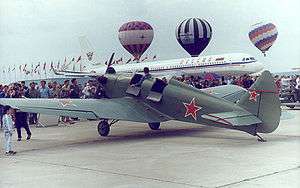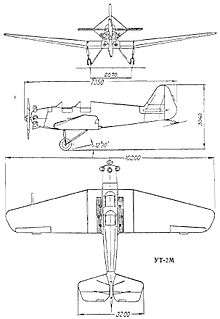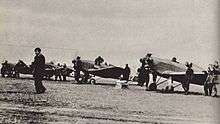Yakovlev UT-2
| UT-2 | |
|---|---|
 | |
| UT-2 survivor at Monino | |
| Role | Trainer |
| National origin | USSR |
| Manufacturer | Yakovlev |
| Designer | Aleksandr Sergeyevich Yakovlev |
| First flight | 11 July 1937 - Ya-20 |
| Status | retired |
| Primary user | Soviet Air Forces |
| Produced | 1936 to 1948 |
| Number built | 7,243 |
| Developed from | AIR-10, Ya-20 |
| Variants | Yakovlev Yak-5 |

The Yakovlev UT-2 (Russian: Яковлев УТ-2; NATO reporting name "Mink") was a single-engine tandem two-seat low-wing monoplane that was the standard Soviet trainer during the Great Patriotic War. It was used by the Soviet Air Force from 1937 until replaced by the Yakovlev Yak-18 during the 1950s.
Development
The preceding U-2 (Po-2) biplane was no longer a suitable trainer for the faster modern aircraft entering service, and to fill the role, the UT-2 was designed as a trainer.
The new aircraft was designed by Alexander Sergeevich Yakovlev's team at OKB-115. Originally designated AIR-10, it was based upon the AIR-9, but it was simpler, with tandem open cockpits, also omitting slats and flaps. It first flew on 11 July 1935. The AIR-10 won the competition in 1935 and, after minor changes, was accepted as the standard Soviet Air Force trainer. With the disgrace of Alexey Ivanovich Rykov under whom Yakovlev had been working, the initials AIR were replaced with Ya making what would have been the AIR-20 the Ya-20 (Я-20).
The wood-and-metal mixed construction of the AIR-10 was simplified to use only wood to facilitate production, and the AIR-10s 120 hp Renault inline engine was replaced with the 112 kW (150 hp) Shvetsov M-11E radial on the prototype, and the 82 kW (110 hp) M-11Gs in early production aircraft. Serial production started in September 1937. The Soviet VVS (Air Force) assigned the aircraft the designation UT-2 (uchebno-trenirovochnyi {учебно-тренировочный}, trainer).
The UT-2 was not easy to fly and easily entered into spins. The UT-2 model 1940 featured a lengthened forward fuselage, and a change to the 93 kW (125 hp) M-11D radial to attempt to rectify the problem. Despite improvements, the handling and flight characteristics remained challenging.
To further improve handling and stability, the new UT-2M (modernized) variant was developed in 1941 and it replaced the original UT-2 in production. The wing planform was redesigned, with a swept leading edge and a straight trailing edge, and the vertical stabilizer was enlarged.
7,243 UT-2 of all types were produced in five factories between 1937 and 1946. In the 1950s, the UT-2 was replaced by the Yak-18 primary trainer and the Yak-11 advanced trainer.
Before and after World War II the UT-2 was used by civilian organizations, and after the war, UT-2s were also operated by the Polish and Hungarian Air Forces.
Variants

- AIR-10
- precursor
- AIR-11
- three-seat prototype
- Ya-20
- prototype
- UT-2
- initial production variant
- UT-2 (1940 standard)
- improved spin characteristics.
- UT-2 (1944 standard)
- UT-2L
- UT-2 with MV-4
- inline engine for tests.
- UT-2L
- improved 1940 standard with canopy and engine cowling, fuselage similar to early Yak-18 but had fixed undercarriage.
- UT-2M
- production from 1941, new wings and empennage
- UT-2MV
- interim light bomber
- UT-2N (SEN)
- air cushion landing gear testbed[1]
- UT-2V
- bomber trainer
- VT-2
- floatplane variant of basic UT-2
- Yak-5
- single-seat fighter-trainer development of UT-2L
Operators

- Normandie-Niemen unit
- SFR Yugoslav Air Force
- 1st Training Aviation Regiment (1945-1948)
- 104th Training Aviation Regiment (1948-1956)
- Liaison Squadron of 5th Military district (1952-1956)
- Liaison Squadron of 3rd Aviation Corps (1950-1956)
Survivors
The Central Air Force Museum at Monino has an example on display, as does the Technical Museum of Vadim Zadorogny in Arkhangelsk.
Specifications (UT-2, 1940 standard)

Data from Gordon 2005, and Gunston 1995
General characteristics
- Crew: two
- Length: 7.15 m (23 ft 5-1/2 in)
- Wingspan: 10.2 m (33 ft 5-1/2 in)
- Height: 2.99 m (9 ft 10 (tail up) in)
- Wing area: 17.12 m2 (184.3 ft2)
- Wing profile: Göttingen 387[2]
- Empty weight: 628 kg (1,385 lb)
- Gross weight: 940 kg (2,073 lb)
- Powerplant: 1 × Shvetsov M-11D 5 cylinder air-cooled Radial engine, 93.2 kW (125 hp)
Performance
- Maximum speed: 210 km/h (131 mph)
- Cruising speed: 99 km/h (60 mph)
- Range: 1,130 km (702 miles)
- Service ceiling: 5,000 m (16,400 ft)
- Rate of climb: 3.3 m/s (649 ft/min)
Armament
- None[3]
See also
| Wikimedia Commons has media related to Yakovlev UT-2. |
- Aircraft of comparable role, configuration and era
- Related lists
- List of Interwar military aircraft
- List of aircraft of World War II
- List of military aircraft of the Soviet Union and the CIS
Notes and Citations
- ↑ V.B. Shavrov. History of aircraft construction in USSR (1938-1950),
- ↑ Lednicer, 2010
- ↑ the UT-2MV light bomber could carry 2 -4 x 50 kg (110 lb) bombs or 8 x RS-82 rockets.
Bibliography
- Gordon, Yefim (2005). OKB Yakovlev: A History of the Design Bureau and its Aircraft. London: Ian Allan. pp. 36 to 45. ISBN 978-1857802030.
- Gunston, Bill (1995). The Osprey Encyclopedia of Russian Aircraft 1875-1995. London: Osprey. ISBN 978-1855324053.
- Gunston, Bill; Gordon, Yefim (1997). Yakovlev Aircraft Since 1924. Putnam Aeronautical Books. Naval Institute Press. ISBN 978-1557509789.
- Pechersky, E.A. (1940). Самолет ут-2 (UT-2 Aircraft). Moscow: Military Publishing, People's Commissariat of Defense of the USSR.
- Lednicer, David (15 September 2010). "The Incomplete Guide to Airfoil Usage". Retrieved April 2016. Check date values in:
|access-date=(help)